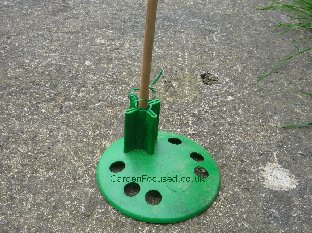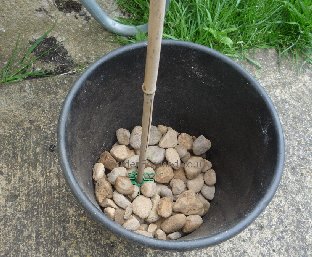HOW TALL IS A STANDARD FUCHSIA
Before you start to grow a standard fuchsia you need to know how tall you want it to be. The reason is simple, a small standard can be grown in one season but a larger standard needs two seasons to reach the height you want and to produce a good head of flowers. The other, far quicker alternative to growing your own large standard is to buy what is called a fuchsia “whip” from a garden centre in April to May time. A “whip” is a trained fuchsia which has grown tall, typically about 1.2m / 4ft or so, where the flower head has not yet formed.
Click to enlarge picture and see more clearly
To help you skip around this article to grow the height of standard you want, we have divided the first part of this page into three sections, when to start growing small standards, when to start growing large standards and growing standards from whips. But before you do that we suggest you use our auto-date adjustment feature which will ensure that all the dates in this article (and the entire website) are permanently accurate for the weather conditions in your home town. Click here to open a new window and do that now. The default is average UK weather conditions as used by other books and websites.
- When to start growing standards from whips
- When to start growing small standards
- When to start growing tall standards
WHEN TO START STANDARD FUCHSIAS FROM WHIPS
This is dictated by when they are for sale from garden centres / online. Typically garden centres will sell them around April / May time, specialist nurseries can often sell them March onwards. Whatever time you buy them, they will require protection from frost until
and ideally kept at 10°C / 50°F or higher. There is no problem in the UK with a maximum temperature because the plants will be in full growth and you want to keep them that way. A couple of days in a cool room inside the house will not do them any lasting harm but if kept indoors for much longer they will begin to suffer from the dry atmosphere.
WHEN TO START GROWING SMALL STANDARDS
Small standards are capable of being grown in one season if you start the process off early enough. By a small standard we mean one which has a bare stem length up to 30cm / 12in. This will give you a plant which is 45cm / 18in high plus the height of the pot. These make beautiful plants and are an ideal way to start off growing standard fuchsias. The growing method is the same as for a tall standard but you start off early in the year and then begin to form the flower head later in the same year. The first decision is the variety of fuchsia to choose. For a small standard you want an upright bush type which produces single flowers which are not too large. The choice is yours, we can recommend four varieties, Checkerboard, Celia Smedley, Heidi Ann and Pink Fantasia.
Now to the crucial factor, the timing of when to buy your fuchsia. The rule is simple, buy as early in the season as you can. How early and what form it takes will depend to a great degree what is available in your area. One key problem is that most fuchsias are not sold online until mid to late March. The reason is that sending frost tender plants through the post any earlier than that makes the risk of frost damage damage very likely. Whichever method you use to source your fuchsias for standards it is essential that the growing tip has NOT been pinched out.
We outline below the options you have and leave it up to you to investigate what is most practical in your area:
- Buy plug plants from your local garden centre. As a general rule garden centres sell plug plant fuchsias earlier than online suppliers simply because they don’t send them through the post.
- Visit a specialist fuchsia nursery, most of them have rooted cuttings available for collection in mid January. Phone before visiting to ensure they are open and have what you want.
- Buy more developed plants online for postal delivery in March from specialist fuchsia nurseries.
If you buy your fuchsias in January to March you will need to provide a frost free environment for them until the last frost date in your area which is
WHEN TO START GROWING HALF OR FULL STANDARD FUCHSIAS
It’s not possible to grow a half or full sized standard in one season therefore you need to begin the process in May for a full standard or August / September for a half standard. You can expect to have your half standard ready for late June or a full standard in mid July. A full standard generally has a bare stem between 76cm / 30in and 106cm / 42in whereas a half standard has a bare stem between 46cm / 18in and 76cm / 30in. However, these measurements are only relevant if you want to display your standard at a show, in all other cases they are irrelevant.
RECOMMENDED STANDARD FUCHSIA VARIETIES
As far as varieties go for your standard the choice is unlimited. We would recommend strong growing, upright varieties so that the plant will grow as quickly as possible. Our own personal favourite varieties include the following in no particular order:
- ARMY NURSE – semi-double flowers coloured carmine, violet and pink this is strong-growing and upright. Easily available from garden centres and online.
- WINSTON CHURCHILL – pink and purple double flowers this is a strong-growing upright variety which never fails to please. Awarded an RHS AGM, it forms the ideal shape for a standard.
- DOLLAR PRINCESS – double flowers which are pink, purple and red, this variety has pleased generations of fuchsia growers. Upright and bushy it makes a superb standard.
- SNOWCAP – hardy in many areas of the UK. Scarlet-red and white flowers. Grows equally well in open ground or a good-sized container. Bushy and upright, they have a well deserved RHS Award of Garden Merit.
If you are planning to start growing a full standard in May then the full choice of over 3,000 varieties will be available to you from online, specialist nurseries and garden centres. If you are starting off a half standard in August / September then the choice will still be large but some of the more unusual varieties may be hard to find. The garden centres won’t be selling them at this time of year but online and specialist nurseries will.
FROST PROTECTION FOR HALF AND FULL STANDARD FUCHSIAS
This section describes how to overwinter half and full standards which have been started as cuttings / plug plants in that year. It does not deal with over-wintering full and half standards which are established plants.
The reason to separate the two stages are because fully-formed, mature standard fuchsias take up a lot more room compared to ones which have been started off in the same year. Also, a standard fuchsia in its first winter will still be growing, even if very slowly. Both full and half standards will require frost protection from mid / late October through to mid / late spring the next year and this is probably the most challenging part of growing standards. To over winter your growing plant will require a temperature in the range 5°C / 41°F to 10°C / 50°F. Now let’s just consider that temperature range because it is the most quoted one for overwintering fuchsias – it is obviously impossible to keep to that temperature range in the UK unless you have both a source of heat and a means of cooling the air down. Many parts of the UK reach above 10°C / 50°F for more than the odd day or so in late winter /early spring and unless you have air-conditioning in your greenhouse / conservatory you will exceed that temperature range as will every other fuchsia grower!
The more practical advice is to aim for the suggested temperature range but accept that both the top and lower ends of it will not always be achievable. The methods which can be used to over winter your plants include:
- In a greenhouse which can be heated slightly when temperatures fall. If you can provide this environment then you are lucky and over wintering will not be a problem. The doors should be left open when temperatures exceed 10°C / 50°F and heating used when the temperature falls to 5°C / 41°F.
- In a conservatory is probably the best option of all. Not only do they have height and space but the heat of the house will keep the conservatory at just about the ideal temperature if not heated. Open the doors when temperatures exceed 10°C / 50°F. A conservatory is unlikely to fall below 5°C / 41°F if attached to a heated house but if it does, temporarily open the door from the house to the conservatory.
- Small plastic mini-greenhouse. These can be bought for £15 or so, maybe cheaper towards the end of the season in September / October when you need it for your fuchsias. Position it against the outside wall of a centrally heated room. We use a couple of these for our fuchsias and they work well. They are a bit flimsy but if they are a against a wall and out of the way of strong winds they will last several years. See the picture below. In very cold weather it may be necessary to bring the plants indoors for a day or so but given this is a very cheap solution which works well for almost all of the winter, that’s a price we are willing to pay.
We don’t recommend trying to grow any size of standard fuchsia indoors for more than a few days. The heat levels will be too high and the dry atmosphere is not good at all for the plants.
ADJUSTABLE CALENDAR FOR FUCHSIA STANDARDS
The sections which follow describe in detail how to grow your standard fuchsia through the summer, winter and the next spring and it contains all the necessary dates in the text adjusted to your area of the UK if you have set your home town (dates default to UK average if no setting is made).
To help you obtain an overall view of the process we have additionally provided individual summary calendars, one for half-standards and one for full sized standards. Click here for the full standard summary calendar or click here for the half standard summary calendar if you want to see one of these summary pages. They will open in a new window so that you can flick between this article and the summary calendar.
GROWING THE STEM OF YOUR STANDARD FUCHSISA
To grow any size of standard you need to start off with a plant that has only one main stem. If you have bought a plug plant or a small plant it may well have more than one stem and you need to pinch out all stems except the main central one.
Using the picture above to illustrate, stem 1 is clearly the strongest growing central stem and stems 2 and 3 should be pinched / cut out to leave only stem 1. Note carefully that the chosen stem must not have been pinched out (growers sometimes do this to bush out the plants). Now take a look at the leaf nodes of the plant you have and you will notice that two side stems are forming or have formed, one each side of the leaf node. See the photo below (click it to enlarge it and see more clearly) which shows a leaf node where the side stems are clearly formed.
When the side shoots are large enough to handle they should be removed. The easiest way to do this is to bend the side shoot sideways and it will snap off. Alternatively you can cut the side shoots off but each time you do that be careful not to damage the main stem. Remove every side shoot in the same manner. Do not remove the leaves, these will assist the plant in absorbing sunshine which gives the top part of the plant lots of energy to grow
quickly.
After a six weeks or so you will have a partially formed standard fuchsia which looks like the one in the picture below. Note that the main leaves have been left on, all the side shoots have been removed as they grew and the very top central part of the the stem has not been pinched out.
CARING FOR A STANDARD FUCHSIA AS THE STEM GROWS
Throughout the growing life of your standard fuchsia it will need to be potted-up three times. We normally aim for a final pot size of 30cm to 45cm (12in to 18in) wide for a full standard and around 30cm / 12in for a half standard. The pot size is important for three reasons:
- the roots need sufficient room to grow and absorb nutrients to support the flower head
- the compost in the pot needs to be able to hold a fair amount of water so that very frequent watering is not needed, the smaller the pot the more frequently it will need watering
- there needs to be some weight in the pot so that it will not be easily blown over; read further down this page for more information about how to stabilise the plant and the pot.
A standard fuchsia should be potted up when the fibrous roots are clearly visible at the edges of the root ball. To see the root ball simply tip the plant upside down into the palm of one hand and gently tap the base of the pot. The plant and root ball will fall out and you can examine it.
One word of warning here which other articles appear not to mention is that when the standard gets much above 60cm / 2ft high (from compost top to tip of the plant) it becomes increasingly dangerous to tip the plant out of its pot without risk to the stem. The stem is long and fragile and can easily be damaged. For this reason we always pot up into the final sized pot when the standard stem gets to 60cm / 2ft high. Read the section below entitled “staking a standard fuchsia” before you do the final pot-up because the final one is done slightly differently to previous ones.
REMOVING SIDE SHOOTS AS THE STANDARD GROWS
As your standard grows taller pinch out the side shoots which appear at each leaf node but do not remove the large leaves. The picture below shows a before and after of removing the side shoots.
Close up showing shoots to remove.
Click to enlarge picture.
Close up showing side shoots removed.
Click to enlarge picture.
By removing the side shoots you will encourage the plant stem to grow straight up rather than bush out. When the plant reaches 20cm / 8in below the final chosen height stop removing the side shoots. You want to leave the top three leaf nodes with the side shoots still in place, these top three side shoots will then form the flower head.
When the stem reaches the required height and it has three sets of side shoots at the top you need to pinch out the growing tip. This will stop the main stem growing upwards and encourage the stop three sets of side shoots to grow and bush out. The two pictures below show the before and after of this pinching out.
The top of the standard before pinching out.
Click picture to enlarge.
The top of the standard after pinching out.
Click picture to enlarge.
FEEDING AND WATERING
When the plant is in full active growth from the cutting / plug plant stage until it goes semi-dormant in the
it should be given a balanced nitrogen feed (not a tomato type feed) every week or two. Watering should keep the compost slightly moist but not water-logged.
Then from the water infrequently keeping the compost barely moist but don’t allow it to dry out completely. At the same time stop the balanced nitrogen feed. In late December and February sprinkle a small handful of blood, fish and bone onto the compost surface and gently work it into the top layer.
In start feeding again with a balanced nitrogen feed and resume watering to keep the compost moist but not water-logged. When the flower head starts to develop well (see pinching out above) start feeding with a tomato type fertilise to encourage the growth of flowers.
STAKING A STANDARD FUCHSIA
Both half and full standards need their stems to be supported to avoid damage from wind. Even the strongest stake in a pot will not protect your plant from very strong winds so the first rule is to place the plant in a protected position. When your cutting or plug plant is growing in its first pot no real staking is required because the plant will naturally grow upright to a large degree if pruned as we recommend.
At the first potting up add a thin stake about 1cm away from the main stem. If the stake is thin and it is gently eased into the compost it will hardly damage the roots at all. Loosely tie the stem to stake so that it encourages the stem to grow straight and vertically. As long as the ties are loose it doesn’t really matter what you use, we normally used thick string.
When the fuchsia comes to the second potting up remove the initial stake and insert a slightly thicker one which is also taller than the existing plant. Again tie the stem loosely to the plant although slightly more tighter ties can be used to correct any imperfections in straightness as long as they are loosened a week or so later.
At the third and final potting up the staking becomes crucial because not only will it need to support the plant for the rest of its life when it has a fully formed flower head but it will also be very difficult to replace it if it is not correct. We recommend that you use some type of stake support in the pot to aid stability similar to the one below.
Those stake supports seem impossible to buy new anymore but before I realised those cane supports existed, I made do with a homemade solution which never let me down but did take a little effort.
I bought a small pack of ready mixed concrete, mixed it with water and packed it into a small plastic plant pot. I let the cement semi-set, inserted the bamboo cane into it and let it fully set. I then broke off the plant pot from the cement.
This gave me a bamboo cane with effectively a lump of concrete at one end. This, when surrounded by potting compost, gave a much more stable bamboo cane which was far less likely to move compared to the cane by itself.
The procedure for the final potting up, secure staking and planting is as follows:
- Select the correct final pot size, 30cm to 45cm (12in to 18in) wide for a full standard and around 30cm / 12in for a half standard.
- Fill the bottom with a layer of grit or stones about 3cm / 1in deep. place the stake support over the stones so that the stake hole is in the middle of the pot and the stake holder is level. Insert a stake into the hole of the stake holder. The length of the stake should be tall enough to reach up to the bottom of the flower head.
- Add another layer of gravel / stones about 3cm / 1in deep.
- Begin to infill the pot with compost so that when the root ball is placed on the top it will be just below the rim of the pot.
- Now the slightly scary bit! Lift the plant and root ball out of the existing pot and place it just off centre at the top of the stake. Find the hole made by the previous stake then gently push the root ball into the stake at that point and down it to the layer of compost in the new pot. The stake must be off centre to avoid it pushing into the main stem of the plant but not too far away from it. There will be some root damage at this stage but it will be minor only. See picture below.
- Infill with compost so that the top of the root ball is level with the new compost. Your standard fuchsia is now potted up into its final container and ready to grow on.
The leaves of your standard fuchsia, which should still be growing from the stem, can be removed when the flower head reaches a decent size, normally about four to six week after the top has been pinched out. Below are two pictures of standard fuchsias we grew last year.
The plant above was grown taller than normal as an experiment. The main problem with a standard this size is protecting it from being blown over!
A less ambitious half standard with a large flower head.
CALENDAR |
TAKING CUTTINGS |
PINCHING OUT |
FUCHSIA CARE |
PEST, DISEASE |
STANDARD FUCHSIAS |
OVER-WINTER |
COMMENTS / QUESTIONS LEFT BY OUR READERS
| Date: 19 July 2021 | From: Claire F |
| QUESTION: I had a standard fuschia which doed back over winter after snow. I trimmed the trunk down to about 6 inches high and it has sprouted numerous whips in every direction. Can I retrain it into a standard again ?
ANSWER: Not really. You could cut out all but one whip and encourage it to grow upwards but there will always be a lump at the cut off point. I would recommend you star again next year. |
|
| Date: 11 July 2020 | From: Colin D |
| QUESTION: I have bought a standard fuchsia in full bloom. These flowers are now finishing. Will it re-flower and if so what can I do to make this happen?
ANSWER: Almost certainly it will re-flower.Remove dying flowers (and the little berry at the base of each flower) and feed with liquid tomato fertiliser according to the pack instructions. Do not prune it at all, that will only delay flower production. |
|
| Date: 8 May 2020 | From: Dave |
| QUESTION: I have just purchased two half standard fuchsias which appear well looked after and established but just require repotting. Both have a mini cluster of shoots coming out of the base, should these be removed?
ANSWER: Yes, do remove them as close to the main stem as possible. If left they will continue to grow and spoil the shape of the standard. |
|
| Date: 7 May 2020 | From: Barbara |
| Are standard fuchsia hanging ones Or are they to be clipped to be Shaped
ANSWER: Standard fuchsias are those which have a bare stem for 2 or 3 foot and a top where leaves and flowers are produced. Hanging fuchsias – I’ve not heard that phrase but I think you are referring to trailing fuchsias. With trailing fuchsias, the stems trail down rather than being upright as is the case with bush fuchsias. Note that both trailing and bush fuchsias can be grown as standards. |
|
| Date: 30 September 2015 | From: Jean M |
| Will my standard fuchsias survive outside during the winter months?
ANSWER: In most UK areas the answer is no. A frost will kill the head of a normal fuchsia. Hardy varieties may do better, depending where you live but even so, standard fuchsias are always at risk of frost damage. To overwinter a full standard you will need to protect it from frost, a cool conservatory is the best environment. A frost free greenhouse is the next best option. If neither of those is available, they can be stored in a frost-free garage for the coldest months. The lack of light will not be a problem because the plant will be in hibernation mode at that time of year. |
|
| Date: 19 April 2015 | From: Sharyn |
| I found these on Amazon which may do: Click here for the link.
They also sell 2 for 89p |
|
| Date: 12 January 2015 | From: Helene |
| Hello, and thanks for an excellent website! Just a quick question, where did you buy the plant stake support you put in the bottom of the pots for the fuchsia standards? I have tried searching online but cant get any hits. Would very much appreciate a link to an online supplier. Thanks!
ANSWER: Thanks for that question. The cane supports I have were inherited from my partner’s father and it never occurred to me that they would be difficult to find.Currently I can find only one supplier and they are on E-bay. I can’t vouch for the company selling them but they have good feedback so may be worth a try. They can be found here:http://www.ebay.co.uk/itm/Cane-Support-Upright-Bamboo-Stand-Garden-Pk 10-/221521998851Before I inherited the cane supports, my solution was to fill a small plastic pot with concrete, insert the cane vertically into the concrete and allow it to set. I was then able to place the pot / concrete / cane in the base of the growing pot and covered it with the compost. That worked very well for many years. If anyone knows of additional suppliers of this item let me know and I’ll post them here. |
|
WHY NOT LEAVE YOUR QUESTION / COMMENTS ABOUT THIS PAGE?
ENTER THEM BELOW. EMAIL ADDRESS IS OPTIONAL.
YOUR COMMENTS WILL BE ADDED ABOVE WITHIN A FEW HOURS.














Fuchsia Calendar
Taking Cuttings
Pinching Out
Caring for Fuchsias
Pests and Diseases
Growing Standard Fuchsias
Over-winter Tender Fuchsias
STEP BY STEP GUIDE TO GROWING STANDARD FUCHSIAS
By David Marks
This guide is aimed totally at the amateur gardener looking to grow a standard fuchsia for their own pleasure. We will show you how to grow beautiful, tall fuchsias without any of the fuss and complicated terminology used by some books and online articles.
This is a “hands on” guide, we’ve actually grown these plants ourselves and the pictures prove it! Trust in this guide and your capabilities and together success will be ours.